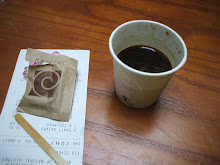
Given the design, typography, and materials, I would have to guess that the package dated from the forties—perhaps even before my grandparents built this house in the early fifties. that guess is helped by the small mark branding the thermometer as a Rexall product. Given the effort to build and brand the Rexall name in the late forties, the timing seems right.
On opening the box, the discovery became even more interesting. Both the manufacturer's mark (Brooklyn!) and the numbers appear to have been hand-painted and hand-etched. It is nearly impossible to imagine any mass market product that has such detail applied in this day and age.


This kind of direct connection to history is unique, I think, to summer homes built in the era when families could truly "summer" in a whole other place than they lived the other nine or ten months of the year. In the cases of some towns along the coast, that meant simply transplanting an entire echelon of society for a few months, i.e. Baltimore money summered on one point while Boston money summered on another point. In the cases of communities such as ours, that meant mixing centuries of local history (families with deep regional ties) with lives lived elsewhere.
The end result is that you find homes filled with artifacts like six decade-old thermometers, spice tins filled with long-stale paprika, toasters that should have died years ago, a grandmother's favorite work gloves, and generations-worth of collected beach treasures. In the case of toasters and appliances, you might feel guilty replacing them because they have nostalgia going for them, but the reality is they continue to work well because they have only been used two months a year for decades. (It is this way with the waffle maker I long since appropriated from the house.) In the case of spice tins, you don't bother replacing them; you simply supplement with fresh spices bought in smaller bulk quantities. The old tins remain because, well, they've always been there.
All this said, I should point out that there are at least two kinds of summer homes. There is the functional sort—cabins, we might call these—where order and nostalgia take a backseat to kids' feet made dirty and wet from trips to the beach. Chaos rules brilliantly in these homes. Then there is the nostalgic sort—cottages, we might call them—where preservation takes precedence and dirt is quickly whisked away. Order rules calmly in these homes.
As I've gotten older and become a parent, I've struggled with what this means to me, whether it's just a nice perq of our family (our summer house) or whether it is a legacy that I must carry on in some way (our living history). I've come to understand (accept?) it as both, but I've also begun to think about how I want Banana to see the place. In the long-run, I suspect my vision may may be noisier than history.

